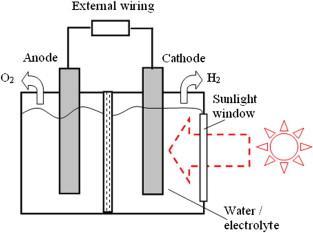
Schematic of a photoelectrolysis unit
-- Source: sciencedirect.
been the best candidate for this process because of its energy storage capabilities, and ease of transportation.
Fortunately, researchers at the National Institute of Standards and Technology (NIST) through a publication in the journal 'Nature Materials' introduce an effective, and inexpensive method of generating hydrogen gas from water using sunlight. The process combines the use of microanalytic techniques that mimic photoelectric current and chemical reaction rates across a surface on a micrometer scale. A semiconducting photoelectrode converts photons of light into energetic electrons that split water molecules into hydrogen and oxygen gases. This process has an efficiency of 12.5%, but is very expensive and has a questionable stability. This research team used a silicon-based device with a metal-insulator-semiconductor (MIS) to curb these issues (ref).
Producing hydrogen from solar energy is the best way this technology can be sustainable in the future. After accounting for stability and cost, the NIST researchers ended with an efficiency of 2.9% -- and they are satisfied with the results saying the design is 15 times better, in cost and stability than any other.
Original article: Nature materials
